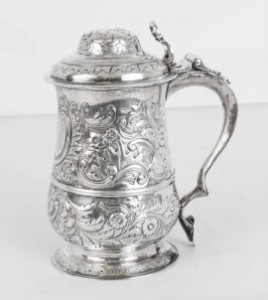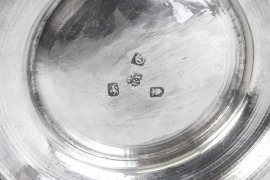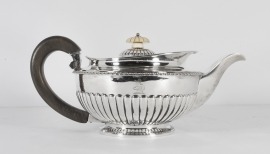Antique Silver at Regent Antiques – A Guide For Buyers
Beautiful pieces large and small from the simple to the highly ornate – buying antique silver allows you to build a collection of truly wonderful objects which are also a solid investment.
A fantastic range of fabulous designs and craftsmanship – antique silver includes cutlery, trays, candle sticks, tankards, plates, tureens and so much more.
Sterling Silver and Silver Plate
Antique silver pieces are either made of sterling silver, which is an alloy of 92.5% pure silver and 7.5% copper (or occasionally another metal) or of silver plate where a base metal, again usually copper, is covered with a layer of pure or sterling silver.
Fine silver, which is 99.9% pure silver is not used to make functional objects as it is too soft.
Silver plating methods such as Sheffield Plating enabled the production of objects which looked and felt like silver but at a much lower cost than sterling silver. Today there are a wide range of antique silver objects on the market made from both sterling silver and silver plate.
Antique Silver Hallmarks
Antique silver is very comprehensively marked making identification generally quite easy. There are usually four symbols – the sterling mark guarantees the purity of the silver – the town mark shows the location of the assay office, there is also a date mark and a maker’s mark. In addition to these basic four marks others marks maybe included such as a sovereign’s head which denotes that tax was paid on the original silver.
Antique Silver -styles, periods and significant designer/makers.
17th century
Much 17th century English silverware is relatively light weight as silver was in quite short supply during this period. English silversmiths of the time were often heavily influenced by Hugenot craftsmen working in England. Paul de Lamerie, a Huguenot immigrant from France is the most well-known silversmith of this period along with Pierre Harache. They both developed distinctive styles during the late 17th century and their work is very highly sought after today.
18th century – Rococo splendour
In the 18th century pieces became heavier and more ornate with plainer pieces giving way to highly elaborate rococo silverware. By the end of the century however fashions changed again and quieter neo-classical work became popular. Matthew Boulton 1728-1809 started a factory in Birmingham in 1762 with John Fothergill. They produced beautiful silver and Sheffield plate domestic pieces, specialising in the Neoclassical Adam style. Hester Bateman 1761-1793 was a very successful London silversmith of the late 18th century with a legacy of highly regarded and sought after tea and coffee pots, spoons, and other domestic wares. Paul Storr 1771-1844 was involved with several successful silverware partnerships and is especially associated with for the Crown-appointed Rundell, Bridge & Rundell.
The Victorian period
In the 19th century great emphasis was placed on weight which became synonymous with quality. The Victorians were fond of intricate and complicated pieces such as highly decorative cutlery. Liberty & Co from 1875, one of London’s leading department stores Liberty’s has always championed artistic innovation especially in the Arts and Crafts and Art Nouveau styles. Important designers who worked with Liberty’s included Archibald Knox, Jessie M King and Oliver Baker. Liberty’s Cymric silverware range, produced from the early 1900s, is highly collectable.
At Regent Antiques we offer a really beautiful range of antique silver from candelabras to cutlery – please contact us to discuss these very special pieces and for an update on our latest stock or visit the website.




